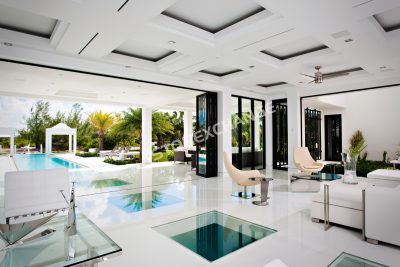 You can watch any home improvement show on television or online and when it comes to achieving that high-end finish, the buzzword is “marble”. There’s no denying the exquisite effect it has. Incorporating marble floors in a building plan takes a project to another level.
You can watch any home improvement show on television or online and when it comes to achieving that high-end finish, the buzzword is “marble”. There’s no denying the exquisite effect it has. Incorporating marble floors in a building plan takes a project to another level.
Builders and contractors who invest in this are typically looking to earn a high margin of profit. For, marble is indeed a costly material, but the benefits of such durable substance justifies this premium product.
It is also basic economics. The demand for marble is high, so the suppliers must strategically increase the price of the product in order to gain a profit from buying at a wholesale price, but cheap enough to beat their competitors. However, it is the builder, contractor, architect, and designer’s job to find the best price.
How Most Builders Use Marble
Usually when it comes to marble, not much creativity is needed when incorporating it into a building plan. Because marble is a type of organic rock, each cut is uniquely designed, having the same color tone variations, and sharing a similar wave pattern, depending on the cut.
Simply installing these marble floors gives a stunning effect that required effort-less design planning. Now, the builders and contractors may choose to mix it up a little by having the marble tiles installed in a way where the wave pattern is laid differently from each other creating an optical illusion of a multi-dimensional flooring. This alone is impressive!
A Different Design Perspective
However, there is much more that builders can do with marble tile. As marble becomes the norm for some people, there will be others who want the ‘new marble’, meaning, they want to be different and possibly out-do and ultimately out-sell their competitor.
How is that done?
It is simply a matter of knowing what your options are and selecting the right type and color combination to ‘play’ with. Nalboor Tiles offers a selective array of color types that are most favored in today’s market.
Adalia Cappuccino–This type of natural marble has warm brown tones speckled with cream and dark yellow. This stone is perfect for creating an elegant, yet cozy atmosphere.
Bianco Dolomiti –This white marble is lightly brushed with silken grey vein lines offering a regal appearance—that is why most hotels and high-end boutiques prefer this type.
Crema Bella – For a slightly warmer and modish look, the Crema Bella will complement almost any kitchen décor. Hailing from Burdur, Turkey, Crema Bella’s cream, beige, and ivory neutral tones are universally compatible with any design, an interior decorator’s dream!
Crema River – The sister to Crema Bella, this natural stone shares the same neutral colors, but with different variations. Crema River’s veining is much darker creating an even deeper mocha-like tone to its surface. This tile is typically used to complement dark cabinetry and fixtures.
Crema Marfil – As this natural stone also share the famous neutral trio of colors, Crema Marfil’s unique characteristic is it’s yellowish gold and minor red veining. That, contrasting to a predominately ivory surface creates a passive aggressive type of neutrality, blending in the background, but demanding to be admired!
Rojo Alicante – Mined from the Aegean parts of west Anatolia Turkey, this exceptional type of natural stone is the boldest color that Nalboor Tiles offers. Rojo Alicante’s autumn-like colors of maroon, rose, and red are typically used as accent tiles.
Creativity: Other Ways to Design Marble Flooring
As each of the type of tiles mentioned can certainly stand on their own, they don’t have to. It can be said that architects and interior designers especially are looking for new ways to design—to do better than their competitors and quite possibly themselves. They want to appeal to the general demand, yet push the envelope. In fact, they may already have a warehouse full of Adalia Cappuccino, Crema Bella, Crema Marfil, and even a pallet of Rojo Alicante. They may not be able to afford to ‘go outside the box’ with designs that may not appeal to their clients and potential buyers.
Examples of Non-Traditional Uses of Marble Flooring
Accent Rug – Decorators may install a permanent accent rug in a floor plan to create a uniquely custom-designed floor pattern that becomes part of building stage rather than the design phase of a construction project.
Framing an indoor pool – What better way to bring more of a wow factor to an indoor pool than to frame it with a beautiful marble design? A Rojo Alicante and Crema Marfil would pair nicely around an aquatic picture.
Distinguishing walkway directions – You may have seen some corporate buildings and hospitals that utilize their flooring as a map, directing patrons to certain areas and/or elevators. If that doesn’t say ‘uptown’, then maybe incorporating marble with this idea will!
So Many Tiles, So Many Design Options!
When you’re ready to take your building floor plan to another level of wow and wonder, consider mixing your existing inventory up to create eye-catching accent marble ‘rugs’, combining colors and different tile sizes, unique framing, and perhaps even efficient mapping, contact Nalboor.
In addition to marble, we offer a range of natural stone, mosaic, engineered, and porcelain tiles. We want to help supply your company with the materials to design an exceptional project that will gain you notoriety amongst your colleagues as well as the competition.
Visit our online showroom to learn more about our products and place an order. Our friendly staff will help you with the process, and you’ll appreciate our wholesale pricing and prompt delivery. Call us today at 305-501-4548.Our office hours are Monday – Friday, from 9am – 5pm
